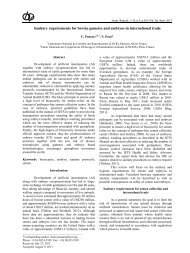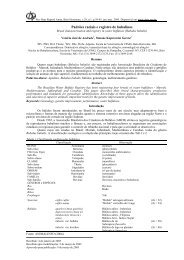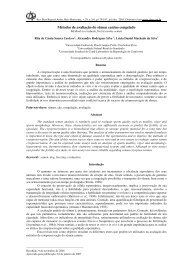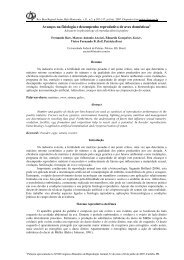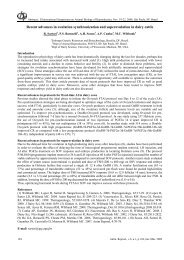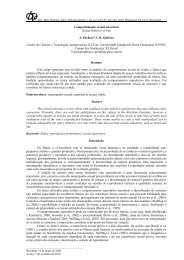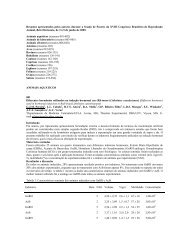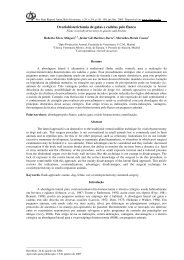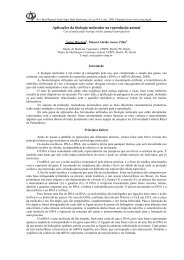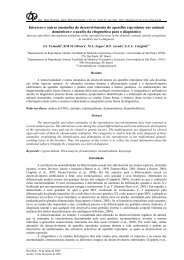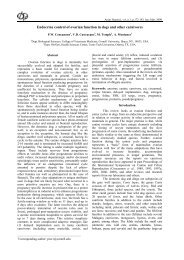Infertility in male dogs: recent advances - Colégio Brasileiro de ...
Infertility in male dogs: recent advances - Colégio Brasileiro de ...
Infertility in male dogs: recent advances - Colégio Brasileiro de ...
You also want an ePaper? Increase the reach of your titles
YUMPU automatically turns print PDFs into web optimized ePapers that Google loves.
Rev. Bras. Reprod. Anim., Belo Horizonte, v.35, n.2, p.266-273, abr./jun. 2011. Disponível em www.cbra.org.br<strong>Infertility</strong> <strong>in</strong> <strong>male</strong> <strong>dogs</strong>: <strong>recent</strong> <strong>advances</strong>Infertilida<strong>de</strong> do macho can<strong>in</strong>o: atualida<strong>de</strong>sA. FontbonneCentre d’Etu<strong>de</strong> en Reproduction <strong>de</strong>s Carnivores (CERCA), Alfort Veter<strong>in</strong>ary College, Paris, France.Correspond<strong>in</strong>g author: afontbonne@vet-alfort.frAbstractVery little is known about <strong>male</strong> <strong>in</strong>fertility <strong>in</strong> the dog. The causes of <strong>in</strong>fertility are divi<strong>de</strong>d <strong>in</strong>to two ma<strong>in</strong>groups, congenital <strong>in</strong>fertility and acquired <strong>in</strong>fertility. Congenital <strong>in</strong>fertility is caused by genetic (chromosomal)abnormalities and is present at birth. Acquired <strong>in</strong>fertility <strong>de</strong>velops dur<strong>in</strong>g the dog's lifetime. <strong>Infertility</strong> <strong>in</strong> <strong>male</strong><strong>dogs</strong> is diagnosed by a good medical history, <strong>in</strong>clud<strong>in</strong>g breed<strong>in</strong>g management, and a physical exam<strong>in</strong>ation.Keywords: dog, <strong>in</strong>fertility, prostate, sperm.ResumoPouco se sabe sobre as causas da <strong>in</strong>fertilida<strong>de</strong> do macho can<strong>in</strong>o. As causas <strong>de</strong> <strong>in</strong>fertilida<strong>de</strong> sãodivididas em dois grupos pr<strong>in</strong>cipais, quais sejam alterações congênitas ou adquiridas. As alterações congênitassão causadas por anormalida<strong>de</strong>s genéticas (cromossomais) e estão presentes ao nascimento. As alteraçõesadquiridas, por sua vez, acontecem no <strong>de</strong>correr da vida do animal. A <strong>in</strong>fertilida<strong>de</strong> do macho can<strong>in</strong>o édiagnosticada por meio <strong>de</strong> um bom histórico, <strong>in</strong>clu<strong>in</strong>do manejo <strong>de</strong> cobertura e exame físico.Palavras-chave: cão, <strong>in</strong>fertilida<strong>de</strong>, próstata, sêmen.IntroductionVeter<strong>in</strong>arians are sometimes asked to diagnose and solve fertility problems <strong>in</strong> the <strong>male</strong> dog. In the caseof some dog bree<strong>de</strong>rs, mat<strong>in</strong>g a stud dog with pure breed bitches proves quite lucrative and br<strong>in</strong>gs fame. Forothers, reproductive expectations are high for a dog which has won several exhibitions or competition shows orhas been genetically selected after several generations. These persons are prepared to conduct several cl<strong>in</strong>ical<strong>in</strong>vestigations to know the cause and the cure of the <strong>de</strong>crease <strong>in</strong> fertility of their dog.Very little is known about <strong>male</strong> <strong>in</strong>fertility <strong>in</strong> the dog. Regard<strong>in</strong>g human <strong>male</strong> <strong>in</strong>fertility, the causerema<strong>in</strong>s unknown <strong>in</strong> 70% to 74 % of cases (Johnston et al., 2001). In the area of human medic<strong>in</strong>e, when thesemen is of poor quality, most of the time assisted reproduction techniques are utilized such as <strong>in</strong> vitroFertilization (IVF) or Intra-Cytoplasmic Sperm Injection (ICSI). These techniques are not rout<strong>in</strong>ely available tothe dog, but may be used <strong>in</strong> the future (Fulton et al., 1998; England et al., 2001); therefore, the prognosis of<strong>in</strong>fertility often rema<strong>in</strong>s very poor. However, some <strong>in</strong>fertility causes can be partially or totally cured if theveter<strong>in</strong>arian is consulted early enough. A complete cl<strong>in</strong>ical survey of the dog is very often important as somediseases may beg<strong>in</strong> by caus<strong>in</strong>g <strong>in</strong>fertility and thereafter creat<strong>in</strong>g a more general health problem. But <strong>in</strong> only 10%of <strong>dogs</strong> presented with <strong>in</strong>fertility may fertility be restored after diagnosis and appropriate treatment (Johnston etal., 2001).Anatomical abnormalities<strong>Infertility</strong> <strong>in</strong> the <strong>male</strong> dog: the different causesHermaphroditism or pseudohermaphroditism (for example, a dog with <strong>male</strong> external genitalia andfe<strong>male</strong> gonads) <strong>in</strong>duces sterility. Congenital <strong>de</strong>fects may <strong>in</strong>clu<strong>de</strong> testicular hypoplasia, epididymal segmentalaplasia, agenesia of the vas <strong>de</strong>ferens, congenital bend<strong>in</strong>g of the penis bone, hypospadias or epispadias, which cancause azoospermia or <strong>in</strong>capacity to mate. If the size of the penis is too small, it may not be reta<strong>in</strong>ed <strong>in</strong>si<strong>de</strong> thevag<strong>in</strong>a dur<strong>in</strong>g copulation, which may cause a lack of volume of sperm <strong>de</strong>posited <strong>in</strong>to the fe<strong>male</strong> genital tract.Bilateral cryptorchidism causes azoospermia, while usually unilateral monorchidism does not create any fertilityproblem (Rhoa<strong>de</strong>s and Foley, 1977). In large breeds, dimorphism may lead to mat<strong>in</strong>g problems when the <strong>male</strong> isso heavy that the fe<strong>male</strong> cannot support its weight dur<strong>in</strong>g <strong>male</strong> overlapp<strong>in</strong>g (Fontbonne, 1999). Aquiredanatomical abnormalities may also cause <strong>male</strong> <strong>in</strong>fertility. Spermatocele or sperm granulomas, stenosis orobstruction of the genital ducts - after an <strong>in</strong>fection for example - or <strong>in</strong>gu<strong>in</strong>al or scrotal hernia, may lead toazoospermia or aspermia. Other acquired abnormalities are strictures after surgery or <strong>in</strong>juries and penis bonefractures. Orthopedic problems (like rachidian or hip diseases) may prevent the <strong>male</strong> from mount<strong>in</strong>g the fe<strong>male</strong>.Palestra apresentada no XIX Congresso <strong>Brasileiro</strong> <strong>de</strong> Reprodução Animal, Recife, PE, Brasil, 25 a 27 <strong>de</strong> maio <strong>de</strong> 2011.
Fontbonne. <strong>Infertility</strong> <strong>in</strong> <strong>male</strong> <strong>dogs</strong>: <strong>recent</strong> <strong>advances</strong>.(Feldman and Nelson, 1996).Abnormal sexual behaviorIn front of a <strong>male</strong> lack<strong>in</strong>g of libido, it is always difficult to know if the un<strong>de</strong>rly<strong>in</strong>g cause is organic orpsychological. One must be aware that the same disor<strong>de</strong>rs caus<strong>in</strong>g <strong>in</strong>fertility with normal libido (bad qualitysemen) may also <strong>in</strong> some cases affect Leydig cells and create a loss of libido (Feldman and Nelson, 1996).Some <strong>dogs</strong> are unable to mate for many various reasons. For unknown reasons, a lack of libido mayoccur at any age <strong>in</strong> <strong>dogs</strong> which were previously capable of mat<strong>in</strong>g. Often it has been noticed that hierarchy playsan important role <strong>in</strong> this regard and that subord<strong>in</strong>ate <strong>male</strong>s do not even attempt to copulate with dom<strong>in</strong>antfe<strong>male</strong>s even at the peak fertilization period of their heats. Some breeds are well known for their lack of libido,like Basset-Hounds or Gol<strong>de</strong>n Retrievers. Some <strong>male</strong>s that may have experienced a pa<strong>in</strong>ful mat<strong>in</strong>g (with anaggressive or a restless bitch for example) may hesitate to try aga<strong>in</strong>. Young <strong>dogs</strong> may also lack experience andold <strong>dogs</strong> may lack libido.The socialization <strong>in</strong> pups plays an important role towards the ability to mate. Pups which have beenseparated at a very young age (before 4 weeks) from their mother and sibl<strong>in</strong>gs may experience problems <strong>in</strong> theirfuture reproductive behavior. Stress just before a mat<strong>in</strong>g is not recommen<strong>de</strong>d (Feldman and Nelson, 1996). Thismay expla<strong>in</strong> that most of the time, the bitch is brought to the <strong>male</strong>’s home for mat<strong>in</strong>g and not the contrary.Miscellaneous causesFailure to achieve erection is quite rare, accord<strong>in</strong>g to our own experience. Such failure may be due topsychological problems, pa<strong>in</strong> or androgen <strong>in</strong>sufficiency. Sometimes, <strong>in</strong>tact <strong>male</strong> <strong>dogs</strong> have been tra<strong>in</strong>ed not tomount bitches <strong>in</strong> heat when they are out of a special room. They will refuse to mate outsi<strong>de</strong> of usual conditions.Young <strong>dogs</strong> presented with <strong>in</strong>fertility with poor quality semen may have just reached puberty andshould be reevaluated at an ol<strong>de</strong>r age. Aged <strong>dogs</strong> may fail to achieve normal copulation due to lack of libido or a<strong>de</strong>crease <strong>in</strong> blood testosterone level. The quality of semen is often reduced <strong>in</strong> ol<strong>de</strong>r <strong>male</strong>s, which <strong>de</strong>creases thefertility rate. Molossoids <strong>dogs</strong> seem to have a <strong>de</strong>cl<strong>in</strong>e <strong>in</strong> quality semen that starts earlier than <strong>in</strong> other breeds.Some authors have noticed that <strong>male</strong>s that mate too often (more than 2 or 3 times daily) may show a<strong>de</strong>cl<strong>in</strong>e <strong>in</strong> libido (Johnston et al., 2001). On the contrary, prolonged sexual abst<strong>in</strong>ence may cause a <strong>de</strong>crease <strong>in</strong>semen quality, especially <strong>in</strong> giant breeds (Fontbonne et al., 1998; Fontbonne, 1999). In humans, it sometimescreates hematospermia. The first ejaculate from a dog follow<strong>in</strong>g a prolonged period of sexual rest conta<strong>in</strong>s agreater percentage of old and <strong>de</strong>ad sperm that have been stored <strong>in</strong> the epididymis (Feldman and Nelson, 1996).There could be a seasonal effect upon fertility, as fertility rates are often lower <strong>in</strong> summer, and thepercentage of normal morphological spermatozoa may <strong>de</strong>crease.Neuropathies like sp<strong>in</strong>al cord <strong>in</strong>juries may enhance a <strong>de</strong>crease <strong>in</strong> libido.Scrotal <strong>de</strong>rmatidis may cause a transient <strong>de</strong>cl<strong>in</strong>e <strong>in</strong> semen quality, due to an <strong>in</strong>crease of the <strong>in</strong>trascrotaltemperature. Obesity, due to the formation of periscrotal fat, may play the same role (Johnston et al., 2001).Fever may also <strong>de</strong>crease spermatogenesis. In humans, high fever causes a <strong>de</strong>cl<strong>in</strong>e <strong>in</strong> semen quality but does notcause complete azoospermia.Improper handl<strong>in</strong>g of semen may be a cause of <strong>in</strong>fertility when the semen is artificially <strong>in</strong>sem<strong>in</strong>ated (8).Mix<strong>in</strong>g with water, ur<strong>in</strong>e or excessive lubricant must be avoi<strong>de</strong>d.Autoimmune orchitis may be associated with azoospermia. It may be connected to autoimmunethyroiditis, with <strong>in</strong>cresased serum antibodies.Little trauma, dog bites, lacerations, kicks or blows (Keenan, 1998) of testes may <strong>de</strong>stroy the barrierbetween the blood flow and the sem<strong>in</strong>iferous tubes and generate an autoimmune spermatogenic arrest due toantisperm antibodies. This disruption of the immunological barrier occurs also <strong>in</strong> the case of Brucellosis,result<strong>in</strong>g <strong>in</strong> sperm agglut<strong>in</strong>ation (Meyers-Wallen, 1991). Agregation of sperm and altered motility have been<strong>de</strong>scribed <strong>in</strong> humans <strong>in</strong> the presence of E. coli (Meyers-Wallen, 1991).Germ<strong>in</strong>al cell aplasia (“Sertoli cell only”) has been reported <strong>in</strong> 1% to 10% of <strong>dogs</strong> with azoospermia(Johnston et al., 2001). Fucisidosis, a lysosomal storage congenital disease affect<strong>in</strong>g the function of epididy<strong>male</strong>pithelial cells and caus<strong>in</strong>g the retention of cytoplasmic droplets, has been <strong>de</strong>scribed <strong>in</strong> the dog (Johnston et al.,2001).At last, idiopathic testicular <strong>de</strong>generation is a common cause of <strong>in</strong>fertility, especially due toazoospermia, <strong>in</strong> the dog (Feldman and Nelson, 1996).Sometimes, <strong>in</strong>fertility is observed <strong>in</strong> <strong>male</strong>s with normal libido and good semen quality. In humans,functional tests like <strong>in</strong> vitro fertilization or zona-free hamster egg penetration may be used. These tests are notrout<strong>in</strong>ely available to the dog. If a <strong>male</strong> dog is mated always with the same bitch, it could be useful to test matethe dog with another bitch to rule out genetic <strong>in</strong>compatibility. On the opposite, some <strong>dogs</strong> rema<strong>in</strong> fertile <strong>de</strong>spitemorphological <strong>de</strong>fects if good breed<strong>in</strong>g management practices are followed (Feldman and Nelson, 1996).Rev. Bras. Reprod. Anim., Belo Horizonte, v.35, n.2, p.266-273, abr./jun. 2011. Disponível em www.cbra.org.br 269
Fontbonne. <strong>Infertility</strong> <strong>in</strong> <strong>male</strong> <strong>dogs</strong>: <strong>recent</strong> <strong>advances</strong>.<strong>Infertility</strong> <strong>in</strong> the <strong>male</strong> dog <strong>in</strong> practiceVeter<strong>in</strong>arians will<strong>in</strong>g to solve a fertility problem <strong>in</strong> the <strong>male</strong> dog must first conduct a very <strong>de</strong>tailedhistory of the general health and reproductive history of the dog. The anterior fertility will be checked carefully.The veter<strong>in</strong>arian will <strong>in</strong>quire about the results of any prior sperm analysis and the number of bitches that weresuccessfully mated, with the litter size each time. A complete general and genital cl<strong>in</strong>ical exam<strong>in</strong>ation must beconducted. Complementary exam<strong>in</strong>ations may, <strong>de</strong>pend<strong>in</strong>g on the case, <strong>in</strong>clu<strong>de</strong> sperm collection and analysis,hormonal assays, ur<strong>in</strong>analysis, ultrasonography, radiography with or without contrast compounds, serological orbacteriological tests, testicular biopsy, PCR… Of course, complementary evaluation should be <strong>de</strong>signed toprogress from relatively easy and <strong>in</strong>expensive to more difficult and time consum<strong>in</strong>g diagnostic tests (Feldmanand Nelson, 1996).Aspermia or oligospermia (lack of volume)The veter<strong>in</strong>arian may suspect a problem related to:• an <strong>in</strong>complete collection of semen (lack of libido or <strong>in</strong>terest of the dog). Normally, a <strong>male</strong> should beg<strong>in</strong> toejaculate with<strong>in</strong> 20 to 30 seconds after manually <strong>in</strong>duced erection;• lack of sexual maturity;• the existence of pa<strong>in</strong> dur<strong>in</strong>g ejaculation;• a prostatic problem;• a retrogra<strong>de</strong> ejaculation;• other causes like neuropathy, sp<strong>in</strong>al cord <strong>in</strong>jury or diabetes mellitus.We first recommend try<strong>in</strong>g to collect the dog a second time, maybe un<strong>de</strong>r better conditions (forexample, us<strong>in</strong>g a teaser bitch <strong>in</strong> heat). Some experienced stud <strong>dogs</strong> will not ejaculate dur<strong>in</strong>g manual semencollection unless presented with an estrous teaser bitch. Sometimes, they even refuse to give semen if they arenot allowed to mount the bitch. Ejaculation may be effected <strong>in</strong> these <strong>dogs</strong> by treatment with GnRH (1 to 2microg/kg SC 2 to 3 hours prior to semen collection) or hCG <strong>in</strong> or<strong>de</strong>r to <strong>in</strong>crease testosterone level.If the result is still a lack of volume of semen, a general cl<strong>in</strong>ical exam<strong>in</strong>ation of the dog must be done <strong>in</strong>addition to a ur<strong>in</strong>e collection by cystocentesis after semen collection (to verify the presence of manyspermatozoa <strong>in</strong> the blad<strong>de</strong>r) and ultrasonography of the prostate gland. Sem<strong>in</strong>al Alkal<strong>in</strong>e Phosphatase should beassayed <strong>in</strong> the liquid collected (see further down paragraph 3 on “azoospermia”)If temporary aspermia is suspected, veter<strong>in</strong>arians can perform a vag<strong>in</strong>al smear <strong>in</strong> the few m<strong>in</strong>utesfollow<strong>in</strong>g a natural mat<strong>in</strong>g with a bitch to see if any spermatozoa can be viewed.In the case of a reduced volume of the prostatic fraction which ren<strong>de</strong>rs the volume of the wholeejaculate very small, treatment may easily be tried by dilut<strong>in</strong>g the sperm-rich fraction of the ejaculate with asynthetic diluent (used for prepar<strong>in</strong>g chilled semen, for example).Treatment of retrogra<strong>de</strong> ejaculation may be attempted by collect<strong>in</strong>g semen when the blad<strong>de</strong>r is full(which makes the sph<strong>in</strong>cter close more firmly). Sympathomimetic drugs like phenylpropanolam<strong>in</strong>e (3 mg/kg peros twice daily) or pseudoephedr<strong>in</strong>e (4 to 5 mg/kg per os three times daily or 1 to 3 hours before semen collectionor attempted breed<strong>in</strong>g) may be tried (Johnston et al., 2001). In humans, spermatozoa ejaculated <strong>in</strong>to the ur<strong>in</strong>aryblad<strong>de</strong>r have been retrieved for artificial <strong>in</strong>sem<strong>in</strong>ation.AsthenozoospermiaNormally, dog semen samples should have more than 70% of the spermatozoa exhibit<strong>in</strong>g vigorousforward motility (Feldman and Nelson, 1996). In <strong>in</strong>fertile men, asthenozoospermia occurs when less than 25% ofspermatozoa have normal motility (Meyers-Wallen, 1991). In dog, this term<strong>in</strong>ology may be used when less than50% of spermatozoa have a normal forward motility (Feldman and Nelson, 1996).• This problem could be due to the follow<strong>in</strong>g:• the collection material that has not been correctly r<strong>in</strong>sed and may harbor spermicidal substances like<strong>de</strong>tergents or toxics: recollect the dog a few hours later after hav<strong>in</strong>g checked everyth<strong>in</strong>g;• an <strong>in</strong>flammation of the ur<strong>in</strong>ary or genital organs, such as prostatitis, cystitis, uretritis. It is useful tocontrol the pH of semen and to perform a ur<strong>in</strong>analysis, ultrasonography of the genital tract <strong>in</strong>clud<strong>in</strong>g theprostate gland, exam<strong>in</strong>ation of the cytology of prostatic fluid, bacteriologic exam<strong>in</strong>ation of sem<strong>in</strong>alfluid, etc• the start of another genital problem, <strong>in</strong>clud<strong>in</strong>g testicular tumors.Do not forget the genetically <strong>in</strong>fluenced immotile cilia syndroms. Diagnosis is ma<strong>de</strong> us<strong>in</strong>g electronmicroscopy.Rev. Bras. Reprod. Anim., Belo Horizonte, v.35, n.2, p.266-273, abr./jun. 2011. Disponível em www.cbra.org.br 270
Fontbonne. <strong>Infertility</strong> <strong>in</strong> <strong>male</strong> <strong>dogs</strong>: <strong>recent</strong> <strong>advances</strong>.Azoospermia or severe oligozoospermiaVeter<strong>in</strong>arians should be aware that <strong>in</strong> many cases of true azoospermia the size of testes rema<strong>in</strong>unchanged.The first problem is to <strong>de</strong>term<strong>in</strong>e if the case represents a true azoospermia or if the collection of semenwas <strong>in</strong>complete, provid<strong>in</strong>g only the pre-sperm fraction without spermatozoa. The semen always should becollected several times as artifactual azoospermia may occur <strong>in</strong> <strong>dogs</strong> that are apprehensive at the time ofcollection and may ejaculate only the first (pre-sperm) fraction (Feldman and Nelson, 1996). For similar reasons,the existence of a prior vasectomy must be ruled out.It is recommen<strong>de</strong>d to assay the alkal<strong>in</strong>e phosphatase concentration <strong>in</strong> sem<strong>in</strong>al fluid. This concentrationis much higher <strong>in</strong> the epididymis than <strong>in</strong> the testes or prostate. A normal <strong>in</strong>tact dog with an <strong>in</strong>completeejaculation usually shows a concentration of this enzyme <strong>in</strong> sem<strong>in</strong>al fluid at less than 5000 units/L, because littleepididymal fluid has been ejaculated. Male <strong>dogs</strong> with true azoospermia, due to causes other than bilateralblockage of the outflow tract usually have concentrations over this level. In <strong>male</strong>s with bilateral obstructiveazoospermia, the concentration may be very low (sometimes as less than 10 units/L). Aspiration of the caudaepididymis may allow verification of spermatogenesis, but it may cause the formation of sperm granulomas andantisperm antibodies.In the case of true azoospermia, ultrasonography of testes may show tumors, or heterogeneous testiculartissue, which makes the veter<strong>in</strong>arian often believe that spermatogenesis is reduced and that the sem<strong>in</strong>iferoustubes are empty (England, 1991; Fontbonne et al., 1998; Fontbonne, 1999).In azoospermic <strong>dogs</strong> with a high concentration of Alkal<strong>in</strong>e Phosphatase <strong>in</strong> the sem<strong>in</strong>al fluid, a completehormonal assessment of the dog should be ma<strong>de</strong> (<strong>in</strong>clud<strong>in</strong>g thyroid functionality). Serum concentration of LHmay be assayed, as it is normal to slightly elevated <strong>in</strong> <strong>male</strong> animals with gonadal failure. FSH could also beassayed. The <strong>de</strong>cl<strong>in</strong>e of spermatogenesis causes Sertoli cells produce less <strong>in</strong>hib<strong>in</strong>. Subsequently, the level ofFSH will <strong>in</strong>crease. It is recommen<strong>de</strong>d to take three blood samples at 20 m<strong>in</strong>ute <strong>in</strong>tervals (as FSH and LH arereleased episodically) or to stimulate the secretion of these hormones with GnRH (250 ng/kg IV, blood sample10 m<strong>in</strong>utes later).Testicular biopsy should be consi<strong>de</strong>red as among the last attempts to know the exact state of <strong>de</strong>cl<strong>in</strong>e ofthe spermatogenesis. If some sperm cells (for example, spermatids) rema<strong>in</strong> present <strong>in</strong>si<strong>de</strong> the sem<strong>in</strong>iferoustubes, the prognosis may not be <strong>de</strong>sperate. In some cases, karyotype could also be evaluated. But, veter<strong>in</strong>ariansmust be aware that <strong>in</strong> most cases, an azoospermic dog rema<strong>in</strong>s azoospermic (Feldman and Nelson, 1996). Onecase of recovery after total azoospermia has been published (Evans and Renton, 1973).Oligo-astheno-teratozoospermia (OAT)The diagnosis procedure of an <strong>in</strong>fertile dog suffer<strong>in</strong>g from OAT will be the same as <strong>in</strong> the previouscase: good cl<strong>in</strong>ical exam<strong>in</strong>ation, ultrasonography, hormonal assessment, bacteriological culture of sem<strong>in</strong>al fluid,etc. Of course, Brucella canis serological test<strong>in</strong>g should always be performed, especially if sperm agglut<strong>in</strong>ationis observed. Everyth<strong>in</strong>g must be done quite quickly, because most of the time OAT is a step towards completeazoospermia (Feldman and Nelson, 1996), and it may be reversible only dur<strong>in</strong>g a short time period.Treatment of OAT <strong>in</strong> <strong>dogs</strong> <strong>de</strong>pends upon etiology. With any treatment, no improvement will occur forat least 62 to 70 days after the start of treatment, that is, the duration of a normal spermatogenic cycle. Someauthors recommend to do noth<strong>in</strong>g <strong>in</strong> the first run: they let the dog rest sexually and re-evaluate after 2 months,hop<strong>in</strong>g that the OAT will have been transient (Feldman and Nelson, 1996).Unilateral castration of <strong>dogs</strong> with unilateral testicular tumors may allow spermatogenesis to improve <strong>in</strong>the contra-lateral testicle.In the case of <strong>in</strong>flammation, the return to normal fertility is unlikely to happen if fibrosis or<strong>de</strong>generative changes have occurred.Medical therapy for idiopathic OAT may be tried us<strong>in</strong>g GnRH given <strong>in</strong> regular pulses (Meyers-Wallen,1991), GnRH agonists, gonadotrop<strong>in</strong>s (hCG (Keenan, 1998), FSH or PMSG) or androgens, like syntheticandrogen mesterolone, which has been shown to improve sem<strong>in</strong>al characteristics <strong>in</strong> three healthy dog and onedog with oligozoospermia (England and Allen, 1991). Testolactone (an aromatase <strong>in</strong>hibitor that prevents theconversion of testosterone to estradiol has been used to treat idiopathic oligozoospermia <strong>in</strong> men with variableresults (Feldman and Nelson, 1996). A <strong>recent</strong> trial <strong>in</strong> <strong>dogs</strong> us<strong>in</strong>g an aromatase <strong>in</strong>hibitor was successful <strong>in</strong>significantly <strong>in</strong>creas<strong>in</strong>g the number of sperm <strong>in</strong> 4 oligozoospermic beagle <strong>dogs</strong> (Kawakami et al., 2004).Based upon our own experience, repeated <strong>in</strong>trauter<strong>in</strong>e <strong>in</strong>sem<strong>in</strong>ations of bitches could be successfulwhen the quality of semen is not too bad and at least 20% to 30 % of spermatozoa show normal progressivemotility. Some authors place half of the ejaculate at the tip of each uter<strong>in</strong>e horn (Keenan, 1998). It has been<strong>de</strong>scribed <strong>in</strong> the case of immune-mediated sperm agglut<strong>in</strong>ation (Keenan, 1998; Johnston et al., 2001). In thiscase, immunosuppressive dosages of glucocorticoids are not recommen<strong>de</strong>d as they affect spermatogenesis andmay <strong>de</strong>crease fertility even more (Feldman and Nelson, 1996).Rev. Bras. Reprod. Anim., Belo Horizonte, v.35, n.2, p.266-273, abr./jun. 2011. Disponível em www.cbra.org.br 271
Fontbonne. <strong>Infertility</strong> <strong>in</strong> <strong>male</strong> <strong>dogs</strong>: <strong>recent</strong> <strong>advances</strong>.In case of genital or ur<strong>in</strong>ary <strong>in</strong>fection, specific antibacterial compounds, <strong>de</strong>pend<strong>in</strong>g upon the antibiogram, maybe used for a long period (at least 3 weeks to one month). Although fluoroqu<strong>in</strong>olones are somewhat expensive,results of their use have often been good (Meyers-Wallen, 1991). Dogs with brucellosis should not be used forbreed<strong>in</strong>g, even after treatment and even if they become seronegative.F<strong>in</strong>ally a dog with frequent sexual usage and low quality semen may rega<strong>in</strong> fertility when usedspar<strong>in</strong>gly to allow spermatozoa to accumulate <strong>in</strong> the epididymis (Feldman and Nelson, 1996).PyospermiaNormal <strong>dogs</strong> should normally have less than 2000 white blood cells per microliter <strong>in</strong> the first andsecond fraction (Keenan, 1998; Johnston et al., 2001).). But the correlation between the number of leukocytesand <strong>in</strong>fection is not clear.Still, if many leukocytes are present <strong>in</strong> the sperm after centrifugation, bacterial culture of the ejaculatedsem<strong>in</strong>al fluid may be done. Do not forget to ask for mycoplasma and ureaplasma i<strong>de</strong>ntification which usuallynecessitate specific transport and culture media (Meyers-Wallen, 1991). Def<strong>in</strong>itive diagnosis of <strong>in</strong>fection of theur<strong>in</strong>ary or reproductive tract can be stated when more than 10 000 bacteria per milliliter of semen are cultured(Keenan, 1998). But it is also sometimes very useful to culture sem<strong>in</strong>al fluid even if no leukocytes are presentafter centrifugation.Cultures must be <strong>in</strong>terpreted cautiously. Bacteria that are isolated may represent a primary <strong>in</strong>fectioncaus<strong>in</strong>g <strong>in</strong>fertility, but they may be contam<strong>in</strong>ants (Feldman and Nelson, 1996). Bacteria isolated <strong>in</strong> semen maybe different from those isolated from testicular tissue or prostatic cysts.HematospermiaDogs with blood <strong>in</strong> the ejaculate are not necessarily <strong>in</strong>fertile (Feldman and Nelson, 1996). Veter<strong>in</strong>ariansshould always check first if any lesion of the penis may bleed dur<strong>in</strong>g erection. If so, a local antisepsis will bedone, and sexual abst<strong>in</strong>ence for several weeks will be recommen<strong>de</strong>d.If no lesion of the penis is observed, a thorough cl<strong>in</strong>ical exam<strong>in</strong>ation of the prostate, <strong>in</strong>clud<strong>in</strong>gultrasonography, must be conducted because a prostatic problem is often the <strong>in</strong>itial cause of hematospermia. Thespecific treatment will <strong>de</strong>pend upon the nature of the prostatic disease.Sometimes, the coagulation parameters should be checked if noth<strong>in</strong>g is viewed either <strong>in</strong> the prostate oron the penis.Failure to achieve erectionDiagnosis of the cause of failure to achieve erection requires the careful observation of copulationand/or semen collection. The veter<strong>in</strong>arian will notice if the dog experiences pa<strong>in</strong>. The localization of the pa<strong>in</strong>will direct further diagnostics. If no semen can be obta<strong>in</strong>ed, a blood sample should be taken to assay androgensand thyrox<strong>in</strong>e levels.Androgen therapy <strong>in</strong> or<strong>de</strong>r to improve libido should be avoi<strong>de</strong>d as it may, <strong>in</strong> fact, cause a <strong>de</strong>cl<strong>in</strong>e of thesemen quality secondary to its suppressive <strong>in</strong>fluence on GnRH and FSH secretion (Feldman and Nelson, 1996).In some cases, electroejaculation un<strong>de</strong>r general anesthesia could be consi<strong>de</strong>red as a mean of obta<strong>in</strong><strong>in</strong>gsemen from very recalcitrant <strong>dogs</strong> (Fontbonne et al., 1998; Keenan, 1998; Fontbonne, 1999).Failure to achieve copulationNon steroidal anti-<strong>in</strong>flammatory drugs <strong>in</strong> <strong>dogs</strong> with pa<strong>in</strong>ful orthopedic conditions may allow limited useof such <strong>dogs</strong> (Keenan, 1998).Dogs with idiopathic poor libido could be given GnRH <strong>in</strong>jections prior to semen collection or breed<strong>in</strong>gattempt, as <strong>de</strong>scribed previously. If they admit semen collection, artificial <strong>in</strong>sem<strong>in</strong>ation is often the best solution.ReferencesDooley MP, P<strong>in</strong>eda MH, Hopper JG, Hsu WH. Retrogra<strong>de</strong> flow of spermatozoa <strong>in</strong>to the ur<strong>in</strong>ary blad<strong>de</strong>r of<strong>dogs</strong> dur<strong>in</strong>g ejaculation or after sedation with xylaz<strong>in</strong>e. Am J Vet Res, v.51, p.1574-1579, 1990,England GCW, Allen WE. Effect of synthetic androgen mesterolone upon sem<strong>in</strong>al characteristics of <strong>dogs</strong>. JSmall Anim Pract, v.32, p.271-274, 1991.England GCW. Relationship between ultrasonographic appearance, testicular size, spermatozoal output andtesticular lesions <strong>in</strong> the dog. J Small Anim Pract, v.32, p.306-311, 1991.England GCW, Verstegen JP, Hewitt DA. Pregnancy follow<strong>in</strong>g <strong>in</strong> vitro fertilisation of can<strong>in</strong>e oocytes, VetRec, v.148, p.20-22, 2001.Rev. Bras. Reprod. Anim., Belo Horizonte, v.35, n.2, p.266-273, abr./jun. 2011. Disponível em www.cbra.org.br 272
Fontbonne. <strong>Infertility</strong> <strong>in</strong> <strong>male</strong> <strong>dogs</strong>: <strong>recent</strong> <strong>advances</strong>.Evans J, Renton JP. A case of azoospermia <strong>in</strong> a previous fertile dog with subsequent recovery. Vet Rec, v.92,p.198-199, 1973.Feldman EC, Nelson RW. Can<strong>in</strong>e and fel<strong>in</strong>e endocr<strong>in</strong>ology and reproduction. 2 nd ed. Phila<strong>de</strong>lphia: WBSaun<strong>de</strong>rs 1996. p.718-733.Fontbonne A, Buff S, Guer<strong>in</strong> P. Abord <strong>de</strong> l’<strong>in</strong>fertilité du chien mâle. Rec Med Vet, v.174, n.314, p.39-60, 1998.Fontbonne A. Infécondité du chien mâle. In: Encyclopédie vétér<strong>in</strong>aire. Pathologie <strong>de</strong> la reproduction, 1900.Paris: Elsevier, 1999. v.5, p.1-13.Johnston SD, Root-Kustritz MV, Olson PNS. Can<strong>in</strong>e and fel<strong>in</strong>e theriogenology. Phila<strong>de</strong>lphia: WB Saun<strong>de</strong>rs,2001. 592p.Kawakami E, Hirano T, Hori T, Tsutsui T. Improvement <strong>in</strong> spermatogenic function after subcutaneousimplantation of a capsule conta<strong>in</strong><strong>in</strong>g an aromatase <strong>in</strong>hibitor <strong>in</strong> four oligozoospermic <strong>dogs</strong> and one azoospermicdog with high plasma estradiol – 17 bêta concentrations. Theriogenology, v.62, p.165-178, 2004Keenan LRJ. The <strong>in</strong>fertile <strong>male</strong>. In: Simpson GM, England GCW, Harvey MJ (Ed.). BSAVA manual of smallanimal reproduction and neonatalogy. Quedgeley, Gloucestershire, UK: BSAVA, 1998. p.83-93.Meyers-Wallen VN. Cl<strong>in</strong>ical approach for evaluat<strong>in</strong>g <strong>dogs</strong> with azoospermia or aspermia. Vet Cl<strong>in</strong> North AmSmall Anim Pract, v.21, p.609-633, 1991.Rhoa<strong>de</strong>s JD, Foley CW. Cryptorchidism and Intersexuality. Vet Cl<strong>in</strong> North Am Small Anim Pract, v.7, p.789-795, 1977.Additional referencesBarsanti JA. Genitour<strong>in</strong>ary <strong>in</strong>fections. In: Greene CE. Infectious diseases of the dog and cat. 2 nd ed.Phila<strong>de</strong>lphia: WB Saun<strong>de</strong>rs, 1998. p.626-646.Bjurstrom L, L<strong>in</strong><strong>de</strong>-Forsberg C. Long term study of aerobic bacteria <strong>in</strong> the genital tract <strong>in</strong> breed<strong>in</strong>g bitches.Am J Vet Res, v.53, p.665-669, 1992.Freshman JL, Amann RP, So<strong>de</strong>rberg SF, Olson PN. Cl<strong>in</strong>ical evaluation of <strong>in</strong>fertility <strong>in</strong> <strong>dogs</strong>. CompendCont<strong>in</strong> Educ Pract Vet, v.10, p.433-460, 1998.Fulton RM, Kesk<strong>in</strong>tepe L, Durrant BS, Fayrer-Hosken R. Intracytoplasmic sperm <strong>in</strong>jection (ICSI) for thetreatment of can<strong>in</strong>e <strong>in</strong>fertility. Theriogenology, v.49, p.366, 1998. Abstract.Guer<strong>in</strong> C, Petit C, Bad<strong>in</strong>and F. Fécondité chez la chienne après saillie ou <strong>in</strong>sém<strong>in</strong>ation artificielle: étu<strong>de</strong> sur202 chiennes. Po<strong>in</strong>t Vét, 28, n.180, p.799-804, 1996.Guer<strong>in</strong> JF. L’<strong>in</strong>fertilité mascul<strong>in</strong>e: notions épidémiologiques. So<strong>in</strong>s Gyn Puer Ped, v.118, p.3-23, 1991.Johnstone I. Breed<strong>in</strong>g difficulties with a stud dog. Aust Vet J, v.62, p.65, 1985.Larsen RE. <strong>Infertility</strong> <strong>in</strong> the <strong>male</strong> dog. In: Morrow DA (Ed.). Current therapy <strong>in</strong> theriogenology. Phila<strong>de</strong>lphia:WB Saun<strong>de</strong>rs, 1980. p.646-654.Oettle EE, Soley JT. <strong>Infertility</strong> <strong>in</strong> a maltese poodle as a result of a midpiece <strong>de</strong>fect. J South Afr Vet Assoc, v.56,p.103-106, 1985.Olson P. Cl<strong>in</strong>ical approach to <strong>in</strong>fertile <strong>male</strong> with sperm <strong>in</strong> the ejaculate. Vet Cl<strong>in</strong> North Am Small Anim Pract,v.21, p.531-608, 1991.Renton JP, Harvey JA, Harker S. A spermatozoal abnormality <strong>in</strong> <strong>dogs</strong> related to <strong>in</strong>fertility. Vet Rec, v.118,p.429-430, 1986.Rev. Bras. Reprod. Anim., Belo Horizonte, v.35, n.2, p.266-273, abr./jun. 2011. Disponível em www.cbra.org.br 273



